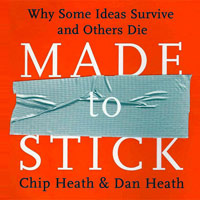
How Small Businesses Create Sticky Content Marketing
During Free Internet Marketing Consulting Saturday this week, a clearly exasperated small business person asked a great question. “You say we have to create great content, but there is already a sea of great content. How can my content stand out?” A chiropractor named Todd asked this excellent question and, after some further discussion, we decided that VIDEO Q&A would be very sticky. As he shared, “I get asked the same questions over and over.”
Sticky Is as Sticky Does – VIDEO Marketing
Video content isn’t as deeply rooted as written content. Video, thanks to embed codes, skims along the surface of the web and is easily shared and promoted on social networks. In fact, Facebook is already the 2nd largest video player behind YouTube, because pictures and videos are the best kind of Facebook content. If Todd the Chiropractor decided to create five videos answering questions about back health, those questions his customers ask over and over, there’s no telling where his Q&A videos could show up.
Couple of things to remember when creating video marketing:
- Don’t JUST host on YouTube.
- Include transcripts to help SEO.
- Short is better than long (1 minute = great).
- Create an umbrella brand, such as Atlantic BT’s “conversations”.
- Q&A is a great format.
- Mix in “B-Roll” and graphics so it’s more than just talking heads.
Use Cliche, Convention and Common Understanding
Made to Stick, the Heath brothers’ book, is my favorite source for HOW TO make Internet marketing ideas sticky. Their biggest lesson? Sell NEW from OLD. The Heath brothers created one of the best examples of how to build awareness of the NEW from an old archetype, analogy or metaphor by pasting a piece of duct tape on the cover of Made To Stick. You don’t have to teach anyone that duct tape is sticky, so their book concept is instantly understood.
Create Personas and Segments
When I describe Cure Cancer Starter, my Story of Cancer nonprofit foundation’s first project, I say, “It is like Kickstarter for cancer research,” to a technical audience. For a non-technical audience, an audience that may not know the crowdfunding platform Kickstarter, I change my pitch to, “Cure Cancer Starter is like Facebook for cancer researchers and patients.” Always use Made to Stick’s main lesson, build the new from the old, but modify your message to your audience.
Persona Examples

Dan the Overworked Man
- Age: 40’s
- Profession: White collar, IT
- Sports: Runs, was a long distance runner in college
- Average Work Week: 60 hours plus some off hour tech support
- Commute: Drives an hour to and from work each day with some traffic
- Family: Married to Sally Stressed and has two teenagers, son Chip and daughter Mary.
- History: Long history of back trouble since college, wears prescription orthopedics when runs.
- Lifetime Value: Customer for more than a year with weekly adjustments.
- Social: Active on social media.
- Technology: Desktop at work, laptop at home and phone when “on call” for tech support.
- Gladwell: Connector / Maven.

Sally Stressed
- Age: 40’s
- Profession: White collar, IT.
- Sports: Plays tennis with a group on Sundays after church.
- Average Work Week: 80 hours (job + managing home front).
- Commute: Drives half an hour to work dropping off junior high school age son Chip and daughter Macy before work.
- Family: Married to Dan the Overworked Man with two teenagers.
- History: Back trouble started after 2nd pregnancy and Macy’s birth.
- Lifetime Value: New customer, only comes once a month when she “can find the time”.
- Social: Active on Facebook and uses Facebook to organize tennis and book club. Also active in PTA.
- Technology: Lives on her phone and iPad.
- Gladwell: Salesperson (Sally is the organizer of her group selling tennis, book club and impromptu meetings).
How to Use Personas & Segments
Dan the Overworked Man and Sally Stressed are the same age and share many of the same environmental stresses. Despite their similarities, Todd the Chiropractor wouldn’t want to make the same offers or use the same language when communicating with Sally and Dan. Sally Stressed is more time compressed and less devoted to adjustments than is Dan the Overworked Man. Chances are good that Dan the Overworked Man sent Sally Stressed to see Todd the chiropractor for her first adjustment. Sally would be defined by Gladwell, in his highly recommended marketing book The Tipping Point, as a “Salesperson”.
Gladwell would define Dan a Maven, a technical expert who shares with his peers. Mavens crave details and may embed and share Todd the Chiropractor’s videos. It is a great idea to ASK A MAVEN what subjects would appeal. Mavens love sharing their advice. Mavens may take Todd the Chiropractor’s videos and embed them on Facebook or include Todd’s videos on their personal blog, especially if they’ve been consulted.
Sally Stressed is unlikely to embed videos, but she might share a video with her friends at tennis or during a book club session. Sally responds to GROUP incentive, so her video should feature more people than Dan’s. Connection is more important than technical details for the Sally Stressed archetype. Todd the Chiropractor might have 15 seconds where 3 to 5 women discuss their adjustments in the round for the Sally Stressed group. Sally Stressed likes to sell her friends, so asking Sally how to appeal to her friends would increase her engagement and help shape Todd the Chiropractor’s message for women in the Sally Stressed group.
How Segments are Different From Personas
It can be tough, when creating personas, to remember you need enough specific information to enable marketing TO the persona and not so much that you’ve created a group of one. An archetype is a macro grouping. Sally Stressed represents a larger group of similar women who balance life, work and family. Dan the Overworked Man represents a group of men who were active in sports in college and have had to make compromises as life’s demands changed their journey. The Dan the Overworked Man group works too much and exercises too little (familiar right?, lol).
Personas and segments are different. You might only have two segments: new and returning customers, with a handful of personas within those two segments. If personas are organized by customer characteristics, then segments are more about how a business operates. Todd the Chiropractor might have a segment each for Chapel Hill, Durham and Raleigh (location), a segment for insurance and non (way customers pay) and a segment for customers who respond to deals (offers). Segments come from a small business’s data and operations. Personas come from customer characteristics (demographics and psychographics).
Data may show the Sally Stressed archetype responds to Groupon promotions, shares Groupon deals with friends and uses those offers in 30 days. The same data may show Dan the Overworked Man hates Groupon offers (low redemption). Some in the Dan the Overworked Man group may go beyond low redemption to complain about how crowded the office becomes with “new people”. Great marketers take feedback like Dan the Overworked Man’s and find ways to create marketing that feeds Sally Stressed’s need for group savings and Dan the Overworked Man’s need for a more intimate relationship with his Chiropractor.
All businesses must grow to prosper. A satisfied customer is the best advertising no business can “buy”. Risking a loyal customer like Dan for more sporadic customers like Sally would be a mistake, as Todd the Chiropractor’s data would show. Use personas to understand your customer’s needs and desires. Use segments to craft offers that don’t rob Peter to pay Paul. Yes, “rob Peter to pay Paul” is an example of a Made to Stick-ism. Also highly recommend: Managing Content Marketing by Rose and Pulizzi for more “How To” help creating personas and segments.
What about you? Did you find this Tip of the Week helpful? What is your tip? Share your experience creating personas and segments, and we will curate your thoughts in.
Join and Follow Atlantic BT
Follow @Atlanticbt on Twitter.
Like Atlantic Business Technologies on Facebook.
Follow @Scenttrail (Marty) on Twitter.









